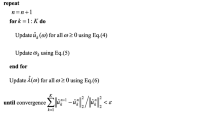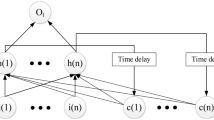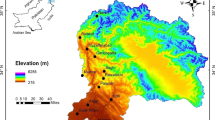Abstract
Hydrological runoff prediction in a reliable and precise manner contributes significantly to the optimal management of hydropower resources. Considering the importance of runoff prediction, this study proposed a hybrid model, namely VBH (VMD-BP), coupling variational mode decomposition (VMD) technique, and backpropagation (BP) based artificial neural network (ANN), to predict the monthly runoff of Fentang reservoir, China. Two hybrid models, including ensemble empirical mode decomposition-BP (EEMD-BP) and empirical mode decomposition-BP (EMD-BP), and a standalone BP model, were also developed for comparative analysis. The VBH model performed better compared to the EEMD-BP model in reducing mean absolute error (MAE) by 40.263%, root mean square error (RMSE) by 33.634%, and mean absolute percentage error (MAPE) by 52.906%. The improved results for the VBH model compared to the EMD-BP model included 103.716, 82.266, and 158.303% reductions in MAE, RMSE, and MAPE, respectively. The error reductions by the VBH model compared to the BP model were 113.848% for MAE, 122.022% for RMSE, and 143.026% for MAPE. The results highlighted that the proposed model was superior to the hybrid and standalone counterparts for the hydrological runoff prediction. Water resources designers and planners for future planning and management of hydrological assets can exploit the proposed model.







Similar content being viewed by others
REFERENCES
Artificial neural networks in hydrology. I: Preliminary concepts, J. Hydrol. Eng., 2000, vol. 5, pp. 115–123.
Artificial neural networks in hydrology. II: Hydrologic applications, J. Hydrol. Eng., 2000, vol. 5, pp. 124–137.
Adamowski, J., Chan, H.F., Prasher, S.O., and Sharda, V.N., Comparison of multivariate adaptive regression splines with coupled wavelet transform artificial neural networks for runoff forecasting in Himalayan micro-watersheds with limited data, J. Hydroinform., 2012, vol. 14, pp. 731–744.
Barzegar, R., Adamowski, J., and Moghaddam, A.A., Application of wavelet-artificial intelligence hybrid models for water quality prediction: a case study in Aji-Chay River, Iran, Stoch. Env. Res. Risk A., 2016, vol. 30, pp. 1797–1819.
Burger, C.M., Kolditz, O., Fowler, H.J., and Blenkinsop, S., Future climate scenarios and rainfall-runoff modelling in the Upper Gallego catchment (Spain), Environ. Pollut., 2007, vol. 148, pp. 842–854.
Cannas, B., Fanni, A., Sias, G., Tronci, S., and Zedda, M., River flow forecasting using neural networks and wavelet analysis, Geophys. Res. Abstr, 2005, vol. 7, p. 08651.
Chandwani, V., Vyas, S.K., Agrawal, V., and Sharma, G., Soft computing approach for rainfall-runoff modelling: a review, Aquat. Procedia, 2015, vol. 4, pp. 1054–1061.
Chen, Y. and Xu, Z., Plausible impact of global climate change on water resources in the Tarim River Basin, Sci. China Ser. D-Earth Sci., 2005, vol. 48, pp. 65–73.
Chu, H., Wei, J., Li, J., Qiao, Z., and Cao, J., Improved medium-and long-term runoff forecasting using a multimodel approach in the Yellow River Headwaters region based on large-scale and local-scale climate information, Water, 2017, vol. 9, p. 608.
Coulibaly, P. and Baldwin, C.K., Nonstationary hydrological time series forecasting using nonlinear dynamic methods, J. Hydrol., 2005, vol. 307, pp. 164–174.
De Vos, N. and Rientjes, T., Constraints of artificial neural networks for rainfall-runoff modelling: trade-offs in hydrological state representation and model evaluation, Hydrol. Earth Syst. Sci., 2005, vol. 9, pp. 111–126.
Dragomiretskiy, K. and Zosso, D., Variational mode decomposition, IEEE T. Signal Proces., 2013, vol. 62, pp. 531–544.
Elganiny, M.A. and Eldwer, A.E., Enhancing the Forecasting of Monthly Streamflow in the Main Key Stations of the River Nile Basin, Water Resour., 2018, vol. 45, pp. 660–671.
Farajzadeh, J. and Alizadeh, F., A hybrid linear–nonlinear approach to predict the monthly rainfall over the Urmia Lake watershed using wavelet-SARIMAX-LSSVM conjugated model, J. Hydroinform, 2018, vol. 20, pp. 246–262.
Feng, Z.-K., Niu, W.-J., Cheng, C.-T., and Wu, X.-Y., Optimization of hydropower system operation by uniform dynamic programming for dimensionality reduction, Energy, 2017, vol. 134, pp. 718–730.
Fortin, V., Ouarda, T., Rasmussen, P., and Bobée, B., A review of streamflow forecasting methods, Rev. Sci. Eau., 1997, vol. 10, pp. 461–487. (in French)
Guo, Z., Zhao, W., Lu, H., and Wang, J., Multi-step forecasting for wind speed using a modified EMD-based artificial neural network model, Renew. Energ., 2012, vol. 37, pp. 241–249.
Huang, N., Yuan, C., Cai, G., and Xing, E., Hybrid short term wind speed forecasting using variational mode decomposition and a weighted regularized extreme learning machine, Energies, 2016, vol. 9, p. 989.
Huang, N.E., Shen, Z., Long, S.R., Wu, M.C., Shih, H.H., Zheng, Q., Yen, N.-C., Tung, C.C., and Liu, H.H., The empirical mode decomposition and the Hilbert spectrum for nonlinear and non-stationary time series analysis, Proc. Roy. Soc. London A, 1998, vol. 454, pp. 903–995.
Jiang, Z., Sun, P., Ji, C., and Zhou, J., Credibility theory based dynamic control bound optimization for reservoir flood limited water level, J. Hydrol., 2015, vol. 529, pp. 928–939.
Jianwei, E., Bao, Y., and Ye, J., Crude oil price analysis and forecasting based on variational mode decomposition and independent component analysis, Physica A, 2017, vol. 484, pp. 412–427.
Karthikeyan, L. and Kumar, D.N., Predictability of nonstationary time series using wavelet and EMD based ARMA models, J. Hydrol., 2013, vol. 502, pp. 103–119.
Khair, U., Fahmi, H., Al Hakim, S., and Rahim, R., Forecasting error calculation with mean absolute deviation and mean absolute percentage error, J. Phys. Conf. Ser., 2017, vol. 930, p. 012002.
Kisi, O. and Kerem Cigizoglu, H., Comparison of different ANN techniques in river flow prediction, Civil Eng. Environ. Syst., 2007, vol. 24, pp. 211–231.
Lahmiri, S., A variational mode decompoisition approach for analysis and forecasting of economic and financial time series, Expert Syst. Appl., 2016, vol. 55, pp. 268–273.
Li, H., Zhang, Y., and Zhou, X., Predicting surface runoff from catchment to large region, Adv. Meteorol., 2015, vol. 2015.
Lohani, A., Kumar, R., and Singh, R., Hydrological time series modeling: A comparison between adaptive neuro-fuzzy, neural network and autoregressive techniques, J. Hydrol., 2012, vol. 442, pp. 23–35.
Mahgoun, H., Bekka, R.E., and Felkaoui, A., Gearbox fault diagnosis using ensemble empirical mode decomposition (EEMD) and residual signal, Mech. Ind., 2012, vol. 13, pp. 33–44.
Maier, H.R. and Dandy, G.C., Neural networks for the prediction and forecasting of water resources variables: a review of modelling issues and applications, Environ. Modell. Softw., 2000, vol. 15, pp. 101–124.
Mosavi, A., Ozturk, P., and Chau, K.-w., Flood prediction using machine learning models: Literature review, Water, 2018, vol. 10, p. 1536.
Napolitano, G., Serinaldi, F., and See, L., Impact of EMD decomposition and random initialisation of weights in ANN hindcasting of daily stream flow series: an empirical examination, J. Hydrol., 2011, vol. 406, pp. 199–214.
Niu, W.-J., Feng, Z.-K., Zeng, M., Feng, B.-F., Min, Y.-W., Cheng, C.-T., and Zhou, J.-Z., Forecasting reservoir monthly runoff via ensemble empirical mode decomposition and extreme learning machine optimized by an improved gravitational search algorithm, Appl. Soft Comput., 2019, vol. 82, p. 105589.
Nourani, V., Kisi, Ö., and Komasi, M., Two hybrid artificial intelligence approaches for modeling rainfall–runoff process, J. Hydrol., 2011, vol. 402, pp. 41–59.
Nunes, J.C., Bouaoune, Y., Delechelle, E., Niang, O., and Bunel, P., Image analysis by bidimensional empirical mode decomposition, Image Vision Comput., 2003, vol. 21, pp. 1019–1026.
Sahay, R.R. and Sehgal, V., Wavelet-ANFIS models for forecasting monsoon flows: case study for the Gandak River (India), Water Resour., 2014, vol. 41, pp. 574–582.
Sang, Y.-F., Wang, Z., and Liu, C., Period identification in hydrologic time series using empirical mode decomposition and maximum entropy spectral analysis, J. Hydrol., 2012, vol. 424, pp. 154–164.
Shortridge, J.E., Guikema, S.D., and Zaitchik, B.F., Machine learning methods for empirical streamflow simulation: a comparison of model accuracy, interpretability, and uncertainty in seasonal watersheds, Hydrol. Earth Syst. Sci., 2016, vol. 20, pp. 2611–2628.
Sibtain, M., Li, X., Nabi, G., Azam, M.I., and Bashir, H., Development of a three-stage hybrid model by utilizing a two-stage signal decomposition methodology and machine learning approach to predict monthly runoff at Swat river basin, Pakistan, Discrete Dyn. Nat. Soc., 2020, vol. 2020, p. 7345676.
Sohail, A., Watanabe, K., and Takeuchi, S., Runoff analysis for a small watershed of Tono area Japan by back propagation artificial neural network with seasonal data, Water. Resour. Manage., 2008, vol. 22, pp. 1–22.
Sudheer, K., Gosain, A., and Ramasastri, K., A data-driven algorithm for constructing artificial neural network rainfall-runoff models, Hydrol. Process., 2002, vol. 16, pp. 1325–1330.
Sun, G., Chen, T., Wei, Z., Sun, Y., Zang, H., and Chen, S., A carbon price forecasting model based on variational mode decomposition and spiking neural networks, Energies, 2016, vol. 9, p. 54.
Tan, Q.-F., Lei, X.-H., Wang, X., Wang, H., Wen, X., Ji, Y., and Kang, A.-Q., An adaptive middle and long-term runoff forecast model using EEMD-ANN hybrid approach, J. Hydrol., 2018, vol. 567, pp. 767–780.
Tongal, H. and Booij, M.J., Simulation and forecasting of streamflows using machine learning models coupled with base flow separation, J. Hydrol., 2018, vol. 564, pp. 266–282.
Wang, W.-C., Chau, K.-W., Cheng, C.-T., and Qiu, L., A comparison of performance of several artificial intelligence methods for forecasting monthly discharge time series, J. Hydrol., 2009, vol. 374, pp. 294–306.
Wang, X., Yu, Q., and Yang, Y., Short-term wind speed forecasting using variational mode decomposition and support vector regression, J. Intell. Fuzzy Syst., 2018, vol. 34, pp. 3811–3820.
Wang, Y. and Markert, R., Filter bank property of variational mode decomposition and its applications, Signal Process., 2016, vol. 120, pp. 509–521.
Wang, Z., He, G., Du, W., Zhou, J., Han, X., Wang, J., He, H., Guo, X., Wang, J., and Kou, Y., Application of parameter optimized variational mode decomposition method in fault diagnosis of gearbox, IEEE Access, 2019, vol. 7, pp. 44871–44882.
Wu, C. and Chau, K.W., Rainfall–runoff modeling using artificial neural network coupled with singular spectrum analysis, J. Hydrol., 2011, vol. 399, pp. 394–409.
Wu, Z. and Huang, N.E., Ensemble empirical mode decomposition: a noise-assisted data analysis method, Adv. Adapt. Data Anal., 2009, vol. 1, pp. 1–41.
Yeh, J.-R., Shieh, J.-S., and Huang, N.E., Complementary ensemble empirical mode decomposition: A novel noise enhanced data analysis method, Adv. Adapt. Data Anal., 2010, vol. 2, pp. 135–156.
Yildiz, S. and Degirmenci, M., Estimation of oxygen exchange during treatment sludge composting through multiple regression and artificial neural networks (estimation of oxygen exchange during composting), Int. J. Environ. Res., 2015, vol. 9, pp. 1173–1182.
Young, C.-C. and Liu, W.-C., Prediction and modelling of rainfall–runoff during typhoon events using a physically-based and artificial neural network hybrid model, Hydrol. Sci. J., 2015, vol. 60, pp. 2102–2116.
Yu, Y., Zhang, H., and Singh, V.P., Forward prediction of runoff data in data-scarce basins with an improved ensemble empirical mode decomposition (EEMD) model, Water, 2018, vol. 10, p. 388.
Zhang, H., Singh, V.P., Wang, B., and Yu, Y., CEREF: A hybrid data-driven model for forecasting annual streamflow from a socio-hydrological system, J. Hydrol., 2016, vol. 540, pp. 246–256.
Zhang, X., Zhang, Q., Zhang, G., Nie, Z., Gui, Z., and Que, H., A novel hybrid data-driven model for daily land surface temperature forecasting using long short-term memory neural network based on ensemble empirical mode decomposition, Int. J. Environ. Res. Public Health, 2018, vol. 15, p. 1032.
Zhao, X., Chen, X., and Huang, Q., Trend and long-range correlation characteristics analysis of runoff in upper Fenhe River basin, Water Resour., 2017, vol. 44, pp. 31–42.
Zheng, J., Cheng, J., and Yang, Y., Partly ensemble empirical mode decomposition: An improved noise-assisted method for eliminating mode mixing, Signal Process., 2014, vol. 96, pp. 362–374.
ACKNOWLEDGMENTS
This study was supported by the National Natural Science Foundation of China (grant no. 51607105); and the Provincial Natural Science Foundation of HUBEI Province (grant no. 2016CFA097). This financial support is gratefully appreciated and acknowledged.
Author information
Authors and Affiliations
Corresponding authors
Rights and permissions
About this article
Cite this article
Muhammad Sibtain, Li, X., Bashir, H. et al. A Hybrid Model for Runoff Prediction Using Variational Mode Decomposition and Artificial Neural Network. Water Resour 48, 701–712 (2021). https://doi.org/10.1134/S0097807821050171
Received:
Revised:
Accepted:
Published:
Issue Date:
DOI: https://doi.org/10.1134/S0097807821050171




